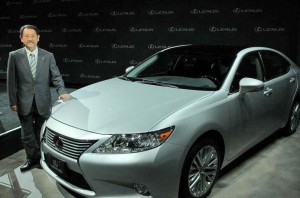Toyota Motor Co. President Akio Toyota confirmed today the maker will invest more than $500 million in its Georgetown, Kentucky plant to move production of one of its Lexus luxury vehicles to the U.S. for the first time.
The recently updated Lexus ES sedan will begin rolling off the line at the maker’s Georgetown plant by 2015, said Toyota, grandson of the automaker’s founder. The move, he noted, reflects the fact that the U.S. is the largest market for the luxury brand – while also sidestepping the negative impact of lopsided exchange rates that have made it increasingly difficult to continue producing vehicles in Japan.
“It is fitting the first country to build the ES outside Japan is the United States because this is home for the Lexus brand,” said Toyoda, a reference to the fact that the luxury marque was, for many years, sold almost exclusively in the U.S. It has, however, begun an aggressive global roll-out in recent years.
While Toyota was slow to embrace the idea of shifting production out of its home market, it has become increasingly aggressive in expanding global operations. It now operates 14 assembly plants in North America, 10 of them in the U.S., which collectively produce seven out of every 10 vehicles sold in the region under the Toyota, Lexus and Scion badges, noted Jim Lentz, who recently was named president of the North American region, the highest rank ever held by an American executive.
Along with the expansion at Georgetown, Toyota is investing $2 billion to boost North American capacity. And that includes additional production geared for 23 overseas markets. Exports rose 45% in 2012, noted Lentz, during a New York City news conference, “and we will export even more vehicles this year.”
The Lexus ES will become the 11th vehicle Toyota assembles in its U.S. plants, and the first for the luxury brand. Toyota is the last of the Japanese “Big Three” to move at least some luxury car production to the States – though it has been producing the Lexus RX crossover in Canada.
But like rivals Honda Motor Co. and Nissan Motor Co., it has been hollowing out production in the home Japanese market due to concerns about exchange rates – as well as potential production issues underscored by the March 2011 Japanese earthquake and tsunami that all but shut down the maker’s operations for much of the following nine months.
The choice of the Georgetown plant was of little surprise considering it is Toyota’s first – and its largest in the States, already producing the critical Camry sedan. With the planned expansion the facility will boost production by 50,000 units annually and increase total investment to over $6 billion. Employment, meanwhile, is expected to rise to 7,400.
“I feel like the state just won the Kentucky Derby,” declared Gov. Steve Beshear, who participated in the webcast from the plant.
Earlier this week, Kentucky officials provided a hint of what was to come when the Kentucky Economic Development Authority confirmed it would provide Toyota with $146.5 million in tax incentives to expand the Georgetown plant and add a new model. Toyota, in turn, will be required to invest $531 million and now confirms it will add 750 jobs by 2015.
In the two years since Japan’s devastating tsunami and earthquake, the pace by which manufacturers have hollowed out the country’s automotive production capacity has been rapidly increasing. There has been some question about whether makers like Toyota might re-think that strategy as the yen has sharply lost value in recent months, reducing the exchange rate penalty.
Despite that shift, however, Nissan CEO Carlos Ghosn said late last month that he does not want to risk the possibility that the yen might again appreciate to the point where Japanese-made cars can no longer be cost-competitive. Toyota appears to be thinking along the same lines.
The Japanese giant has traditionally been the most reluctant to shift production, positioning itself as a defender of the Japanese economy. But it has been increasingly worried about home market production, as well, and the decision to move the Lexus ES to Kentucky suggests further shifts are possible. In particular, most industry analysts anticipate the popular Toyota Prius will eventually be produced somewhere in North America, as well.
Even before the new move, Toyota had invested about $18 billion in its various U.S. operations, including assembly plants, design facilities, research-and-development centers and test tracks. It claims to have 30,000 direct U.S. employees and to indirectly employ 365,000 Americans all told.

